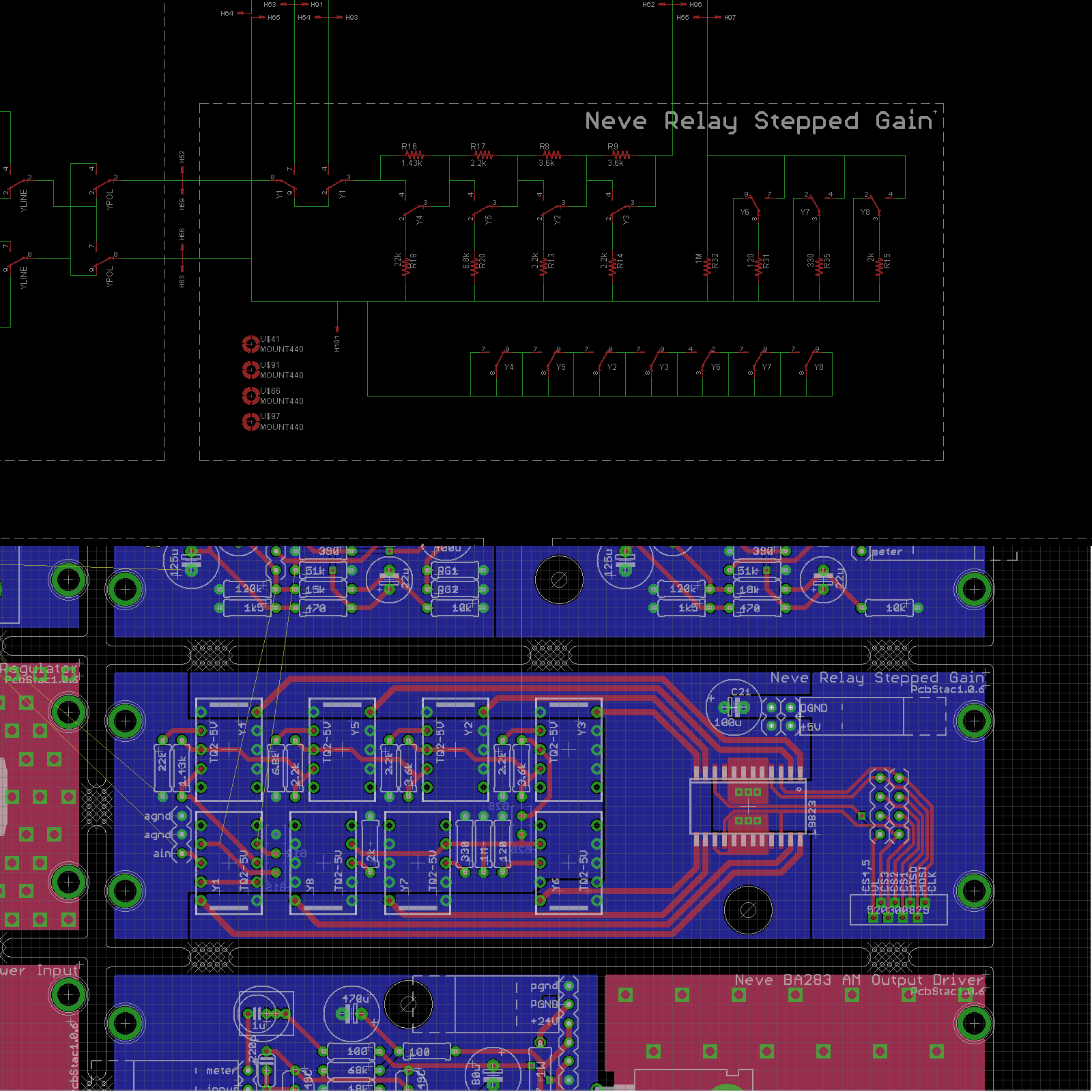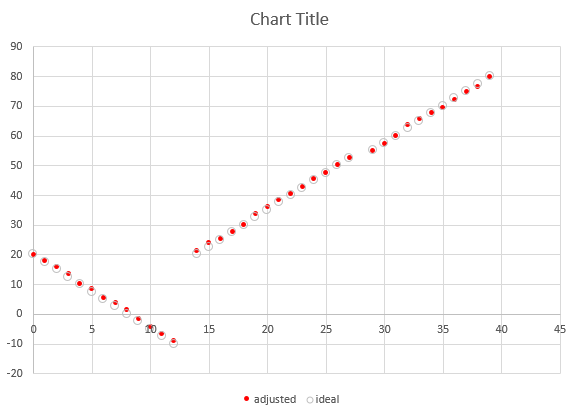You are using an out of date browser. It may not display this or other websites correctly.
You should upgrade or use an alternative browser.
You should upgrade or use an alternative browser.
DIY Neve 1073 +EQ
- Thread starter ilfungo
- Start date
Help Support GroupDIY Audio Forum:
This site may earn a commission from merchant affiliate
links, including eBay, Amazon, and others.
peterc
Well-known member
Hi
I have settled on using the Greyhill switches from Colin at AML. I have tried a bunch of different makes but I think they are the best cosy vs quality option.
http://www.audiomaintenance.com/acatalog/GR-03-001_extended_info.html
http://www.audiomaintenance.com/acatalog/Rotary_Switches.html
All my builds are on PCBs.
Peter
I have settled on using the Greyhill switches from Colin at AML. I have tried a bunch of different makes but I think they are the best cosy vs quality option.
http://www.audiomaintenance.com/acatalog/GR-03-001_extended_info.html
http://www.audiomaintenance.com/acatalog/Rotary_Switches.html
All my builds are on PCBs.
Peter
ruffrecords
Well-known member
For the 1073 gain switch you really need a 3 pole 24 way switch and ELMA is the usual choice but expensive. You could use something like this:
https://www.hificollective.co.uk/switches/blue-4-pole-24-way-switch-gold-plated.html
They are made in China and sold by several companies.
Cheers
Ian
https://www.hificollective.co.uk/switches/blue-4-pole-24-way-switch-gold-plated.html
They are made in China and sold by several companies.
Cheers
Ian
Go for Blore kit.1073 can be tricky to made if you risk with dualconcetric and attenuator switch.ilfungo said:Hi
I'm building Neve 1073 +EQ with original boards
Can someone tell me where buy a good cost alternative for preamp and eq rotary switches?
Thanks!
https://www.blore-ed.com/product-page/neve-1073-module-switch-kit
cheers
Sasha
www.beebirdaudio.com
ruffrecords
Well-known member
ilfungo said:thanks IAN!!!
could you tell me something for EQ switch?
Thanks!
I forget how many poles and ways they are. Can you remind me?
Cheers
Ian
Bo Deadly
Well-known member
I know it's a bit of a leap but you should consider a relay controlled gain. I just did a Neve preamp that uses 8 relays to do -20 to +80dB in 2.5dB steps. Of course the whole point was so that I could use a conventional 10k linear pot. The position of the pot is read by a microcontroller which also controls the relays (along with leds and tactile buttons and everything else). It actually uses less space than the usual 3 pole 24 position rotary switch. And the resolution is better.
Just to give you a vague idea of what I did, this is what the schem and PCB of the relay board look like:

With only 4 relays the attenuator can do 30dB in 2.5 steps because of how the attenuators combine (-2.5, -5, -10, -12.5). Then of course the extra gain stage and the gain boost also combine. It took some trial and error with LTSpice to figure how what resistor values yield the correct impedance. It wasn't clear that it would work at all actually. But all steps are pretty close to the prescribed 5K. Values used are shown in the schem above.
I suppose for most folks writing the code would be the real hurdle to making a relay controlled gain for the Neve. It may not be obvious to a newbie how to "debounce" the potentiometer for example. In short, I just slightly moved the threshold of the step after a step switch. Simple!
I use a table to determine which combination of relays yield the closest step match:
Some steps are off by a dB or so but nothing anyone is going to notice:

Oh, and it's way cheaper BTW.
Just to give you a vague idea of what I did, this is what the schem and PCB of the relay board look like:

With only 4 relays the attenuator can do 30dB in 2.5 steps because of how the attenuators combine (-2.5, -5, -10, -12.5). Then of course the extra gain stage and the gain boost also combine. It took some trial and error with LTSpice to figure how what resistor values yield the correct impedance. It wasn't clear that it would work at all actually. But all steps are pretty close to the prescribed 5K. Values used are shown in the schem above.
I suppose for most folks writing the code would be the real hurdle to making a relay controlled gain for the Neve. It may not be obvious to a newbie how to "debounce" the potentiometer for example. In short, I just slightly moved the threshold of the step after a step switch. Simple!
I use a table to determine which combination of relays yield the closest step match:
Code:
[SIZE=11px]
struct {
int16_t db; // x10
uint8_t rly;
uint8_t flags;
} neve_steps[] = {
{ 200, RN_ATTN(0), FLAG_NEVE_LINE }, // 0
{ 175, RN_ATTN(RLY_NEVE_A2P5), FLAG_NEVE_LINE }, // 1
{ 150, RN_ATTN(RLY_NEVE_A5), FLAG_NEVE_LINE }, // 2
{ 125, RN_ATTN(RLY_NEVE_A5 | RLY_NEVE_A2P5), FLAG_NEVE_LINE }, // 3
{ 100, RN_ATTN(RLY_NEVE_A10), FLAG_NEVE_LINE }, // 4
{ 75, RN_ATTN(RLY_NEVE_A10 | RLY_NEVE_A2P5), FLAG_NEVE_LINE }, // 5
{ 50, RN_ATTN(RLY_NEVE_A10 | RLY_NEVE_A5), FLAG_NEVE_LINE }, // 6
{ 25, RN_ATTN(RLY_NEVE_A10 | RLY_NEVE_A5 | RLY_NEVE_A2P5), FLAG_NEVE_LINE }, // 7
{ 0, RN_ATTN(RLY_NEVE_A12P5 | RLY_NEVE_A5 | RLY_NEVE_A2P5), FLAG_NEVE_LINE }, // 8
{ -25, RN_ATTN(RLY_NEVE_A12P5 | RLY_NEVE_A10), FLAG_NEVE_LINE }, // 9
{ -50, RN_ATTN(RLY_NEVE_A12P5 | RLY_NEVE_A10 | RLY_NEVE_A2P5), FLAG_NEVE_LINE }, // 10
{ -75, RN_ATTN(RLY_NEVE_A12P5 | RLY_NEVE_A10 | RLY_NEVE_A5), FLAG_NEVE_LINE }, // 11
{ -100, RN_ATTN(RLY_NEVE_A12P5 | RLY_NEVE_A10 | RLY_NEVE_A5 | RLY_NEVE_A2P5), FLAG_NEVE_LINE }, // 12
{ -100, 0, FLAG_NEVE_OFF }, // 13
{ 200, RN_ATTN(RLY_NEVE_A12P5 | RLY_NEVE_A5 | RLY_NEVE_A2P5), 0x00 }, // 14
{ 225, RN_ATTN(RLY_NEVE_A12P5 | RLY_NEVE_A5), 0x00 }, //15
{ 250, RN_ATTN(RLY_NEVE_A10 | RLY_NEVE_A5), 0x00 }, // 16
{ 275, RN_ATTN(RLY_NEVE_A10 | RLY_NEVE_A2P5), 0x00 }, // 17
{ 300, RN_ATTN(RLY_NEVE_A10), 0x00 }, // 18
{ 325, RN_ATTN(RLY_NEVE_A5 | RLY_NEVE_A2P5), 0x00 }, // 19
{ 350, RN_ATTN(RLY_NEVE_A5), 0x00 }, // 20
{ 375, RN_ATTN(RLY_NEVE_A2P5), 0x00 }, // 21
{ 400, RN_ATTN(0), 0x00 }, // 22
{ 425, RN_ATTN(0) | RLY_NEVE_B2P5, 0x00 }, // 23
{ 450, RN_ATTN(0) | RLY_NEVE_B5, 0x00 }, // 24
{ 475, RN_ATTN(RLY_NEVE_A2P5) | RLY_NEVE_B10, 0x00 }, // 25
{ 500, RN_ATTN(0) | RLY_NEVE_B10, 0x00 }, // 26
{ 525, RN_ATTN(0) | RLY_NEVE_B10 | RLY_NEVE_B5 | RLY_NEVE_B2P5, 0x00 }, // 27
{ -100, 0, FLAG_NEVE_OFF }, // 28
{ 550, RLY_NEVE_GX | RN_ATTN(RLY_NEVE_A10 | RLY_NEVE_A5), 0x00 }, // 29
{ 575, RLY_NEVE_GX | RN_ATTN(RLY_NEVE_A10 | RLY_NEVE_A2P5), 0x00 }, // 30
{ 600, RLY_NEVE_GX | RN_ATTN(RLY_NEVE_A10), 0x00 }, // 31
{ 625, RLY_NEVE_GX | RN_ATTN(RLY_NEVE_A5 | RLY_NEVE_A2P5), 0x00 }, // 32
{ 650, RLY_NEVE_GX | RN_ATTN(RLY_NEVE_A5), 0x00 }, // 33
{ 675, RLY_NEVE_GX | RN_ATTN(RLY_NEVE_A2P5), 0x00 }, // 34
{ 700, RLY_NEVE_GX | RN_ATTN(0), 0x00 }, // 35
{ 725, RLY_NEVE_GX | RN_ATTN(0) | RLY_NEVE_B2P5, 0x00 }, // 36
{ 750, RLY_NEVE_GX | RN_ATTN(0) | RLY_NEVE_B5, 0x00 }, // 37
{ 775, RLY_NEVE_GX | RN_ATTN(0) | RLY_NEVE_B5 | RLY_NEVE_B2P5, 0x00 }, // 38
{ 800, RLY_NEVE_GX | RN_ATTN(0) | RLY_NEVE_B10, 0x00 }, // 39
};
[/SIZE]
Oh, and it's way cheaper BTW.
ruffrecords
Well-known member
ilfungo said:Thanks to all for suggestions!!!
New info about film capacitors :
is it worth spending so much on the Mustard Caps?
( I will to go closer to original sound)
Thanks!!!
Short answer, not worth it. Mustard caps were made by Mullard in the UK which is mostly why we used them at Neve back in the 70s. Any good film capacitor will be fine.
Cheers
Ian
All signal , and fb connections goes through shielded cable(if you look at attenuator wiring , they are almoist all shielded) .Except maybe OT , there you can use tightly twisted wires.ilfungo said:I'm on wirings!!!
Just one info
where in the circuit I need to use shielded cable ? ( 2 conductor+ Shield or 1+ Shield)
Thanks!!!
ruffrecords
Well-known member
ilfungo said:Thanks
"All signal , and fb connections"
Fb connections?
thanks!
feedback?
Cheers
Ian
boji
Well-known member
"I know it's a bit of a leap but you should consider a relay controlled gain."
Cool squarewave, love it.
Cool squarewave, love it.
Similar threads
- Replies
- 0
- Views
- 1K
- Replies
- 0
- Views
- 954



